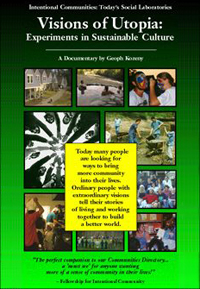 To celebrate Visions of Utopia, for the rest of the month you can view them free online. Use promos “Visions1” and “Visions2” for the free rental, available at https://vimeo.com/
To celebrate Visions of Utopia, for the rest of the month you can view them free online. Use promos “Visions1” and “Visions2” for the free rental, available at https://vimeo.com/
The Fellowship’s first forays into the world of information dissemination were focused on print. After first getting under way in 1987, we produced our first edition of Communities Directory in 1990, and took over as the publisher of Communities magazine in 1992. Two years later we branched out to establish an online presence, and in 1997 it became apparent that we also needed video. Having no one in the FIC family with experience in that medium, Geoph Kozeny volunteered to teach himself how to do.
He secured a $17,000 start-up loan from Bert Bradley (Orca’s Landing in Seattle), and poured himself into the work that eventually produced Visions of Utopia.
Geoph carefully sifted through the hundreds of intentional communities extant to come up with a representative mix of 17 groups which collectively showcased the incredible breadth of options available: from ashrams to co-ops; from cohousing to agricultural communes, from ecovillages to service groups focusing on disadvantaged populations.
While Geoph had many wonderful talents, being a fast worker was not among them. There were always too many others interesting things to distract him. He was also hopelessly optimistic, which meant you had to accept any of his production estimates with a one-pound box of salt. (Think tortoise, not hare.) As an example, most of the images for the Sandhill segment were shot in 1999 (I know because I’m in them), but that community’s profile was not available to the public until 10 years later, when volume two was released. In the end though, that’s nitpicking. The enduring value of Visionsof Utopia is not as a chronicle of what is, but as a documentary of what’s possible, as told by the pioneers of cooperative culture themselves.

The project turned out to be huge. Geoph would shoot 20 hours of raw footage to distill each profile down to 10-12 minutes of final product. In consequence, he spent much more time in the editing room of Village Media (at The Farm in Summertown TN) than shooting on location.
At the outset Geoph expected to produce just one video, but after a couple years it dawned on him that he had way too much material to boil it down to a single two-hour presentation. Thus, he split the project into two parts. Volume One (94 min) came out in 2002, in VHS format. Two years later it was offered as a DVD as well. It featured an historic overview of the Communities Movement, as well as profiles of seven contemporary communities:
- Ananda Village (Nevada City CA)
- Breitenbush Hot Springs (Detroit OR)
- Camphill Special School (Glenmoore PA)
- Earthaven (Black Mountain NC)
- Nyland Cohousing (Lafayette CO)
- Purple Rose (San Francisco CA)
- Twin Oaks (Louisa VA)
Well on his way to completing Volume Two, tragedy struck in 2007. Geoph was diagnosed with pancreatic cancer in June, and he died only four months later. While he had collected almost all of the necessary footage, only one of the 10 segments had been scripted and gone through final editing. Fortunately Geoph and I were able to huddle in those final months, allowing him to pass along instructions for how he wanted the projected completed and I agreed to make it happen.
- Catholic Worker’s House (San Antonio TX)
- Community Alternatives & Fraser Common Farm (Vancouver & Aldergrove BC)
- The Farm (Summertown TN)
- Ganas (Staten Island NY)
- Goodenough (Seattle WA)
- Hearthaven (Kansas City MO)
- Miccosukee Land Co-op (Tallahassee FL)
- N Street Cohousing (Davis CA)
- Remote Hamlet (CA)
- Sandhill Farm (Rutledge MO)
Today both volumes are available either as DVDs or as video that’s downloadable straight to your computer. Even though the images were mostly shot 15+ years ago, it remains the most comprehensive and balanced overview of the Communities Movement in North America. Unlike many other efforts that accentuate the positive (and skate over the challenges), Visions reflected Geoph dedication to offering an even-handed picture of both the joys and the sorrows of community living. Though Geoph is gone, the relevance and inspiration of his magnum opus endures.













